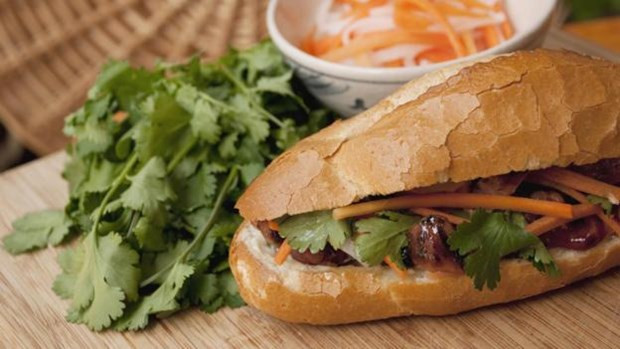Hanoi (VNA) – “Hard to resist” is what Theign YiePhan, a head chef of a restaurant, describes Vietnamese “banh mi” (sandwich),which opens an article entitled “Story of the banh mi: Vietnam’s super sandwich thattook on the world” run in the South China Morning Post.
Along withpho, the noodle soup, banh mi is one of Vietnam’s most famous culinary exports– a French-style bread filled with rich meats and zingy, fresh vegetables andherbs.
Through head chef Theign Yie Phan’s experience, Vietnamese banh mi becomes a anattractive colourful between-service snack.
“It is agood between-service snack. I eat one every other day. It is definitely notsomething you get sick of,” she says with a laugh, as she stands in front of anarray of colourful ingredients ready to be stuffed into a crusty baguette at LePetit Saigon in Wan Chai, the article wrote.
“As asandwich it is well balanced in flavours and textures. There’s the crusty warmbread, the richness of the flavours of the meat, and then the tartness andsourness from the pickles,” says Phan, who is also the head chef of next-doorsister restaurant, Le Garcon Saigon.
Cutting opena baguette, Phan begins layering it with thinly sliced pork belly, terrine andVietnamese sausage, topped off with chicken liver pate and house-mademayonnaise. Next she balances that with slices of fresh cucumber, pickledvegetables, Maggi sauce, coriander, spring onion and chilli – “for punch”.
Phan is notalone in her love of the sandwich. Banh mi has gone from humble beginnings onthe streets of Saigon to become a global sensation – mirroring the history ofmodern Vietnam. So how did a country in Southeast Asia – known for rice andnoodle dishes – originate such a Western specialty as a sandwich?
To seek theanswer, the article’s authors met chef Peter Cuong Franklin who has researchedFrench cuisine’s influence in Vietnam to explore the story of Vietnamese banhmi.
“When theFrench colonised Vietnam, they needed to eat their own food. So they broughtthings like wheat to make bread, cheese, coffee, and other products that theywould consume every day,” Franklin says.
TheVietnamese were gradually introduced to these French foods, he says, thoughthey were expensive back then. Eventually wheat, and the technique for makingbaguettes, were imported, and the locals – in particular the ethnicChinese-Vietnamese – learned how to make bread.
The flavoursof the modern banh mi vary by region in Vietnam. In Hanoi in the north, thefillings are more simple than the “original” found in Ho Chi Minh City in thesouth, and include high-quality cold cuts. In the central coastal city of HoiAn, the meat used is served warm.
“The US is ahub of pop culture, and over the years TV food shows, travel shows, AnthonyBourdain, food blogging and social media” have helped introduce people in theWest to this quintessential fusion Vietnamese dish, says Phan.
Phanbelieves the wider American population embraced banh mi when it was introducedby Vietnamese immigrants because the ingredients used were “familiar” to theAmerican palate.
“Everyoneloves a good sandwich. And in every culture there is some sort of sandwich. Sobanh mi is very accessible culturally, so that’s why it has become so popularworldwide,” she said./.





























